Editor’s Note: In coil coating of aluminum sheet, applied by roll coating or other means, the coated product is subsequently subjected to a short thermal, ultraviolet, and/or electromagnetic curing cycle for drying and curing of the coating. Coil coating of aluminum alloy sheet is forever evolving in terms of pretreatment and top coating compositions, especially of late.
As noted in the 32 selected patents, recently granted by the U.S. Patent Office (June 2018 -October 2019) and presented here, the impetus for this rising scale of invention revolves around unique coating compositions developed by chemists of major chemical companies specializing in coatings used to improve corrosion resistance and paint/coating adhesion in automotive and food and beverage can making markets. Of the patents selected, some 14 of these apply to automotive paint coatings and another 13 to aluminum can coatings, indicative of the problems to be solved in these fields. Other patents selected relate to coil coatings for the B&C market (coating of self cleaning substrates and bilayer coatings containing polyvinyl fluoride); not to mention patents relating to a rapid non-contact coating measurement system, a sorbent coating for dehumidifier surfaces, and a conductor tract coating process. The patent claims and data not only present invented compositions, but coil coating processing steps.
Regarding the subject automotive coil coating patents, their primary focus is to provide chromate-free and/or phosphate-free pretreatment compositions, without serious environmental issues. These special paint coatings impart a corrosion resistance that is equivalent or superior to the conventional conversion and paint coatings. Some of these automotive coil coating patents are ‘smart’ coatings, i.e., coatings that are self-healing if scratched and near-IR sensitive coatings that increase detection sensitivity in autonomous vehicles.
The subject food and beverage can coating patents seek to displace the current coating compositions for containers, which are based on resins that are the polyglycidyl ethers of bisphenol A, introduced into food and beverage can making over 50 years ago. Bisphenol A in packaging coatings either as bisphenol A itself (BPA) or derivatives thereof, such as diglycidyl ethers of bisphenol A (BADGE) are perceived by some as being harmful to human health. Although the balance of scientific evidence available to date indicates that small trace amounts of BPA or BADGE that might be released from existing coatings do not pose health risks to humans, there is a strong desire to eliminate these compounds from coatings for food and beverage containers, hence the surge in R&D and inventive activity in this area. The Aluminum Association understands that ongoing research and study is taking place on the safety and efficacy of BPA and continues to monitor these developments closely, while attesting that established studies point out that exposure to BPA through the normal, day-to-day use of food and beverage containers is safe (www.aluminum.org/bpa-aluminum-cans). As the Association points out, the U.S. Food and Drug Administration (FDA) has deemed current levels of BPA in food and beverage containers as safe. Nonetheless, the proliferation of R&D activities in finding alternatives to BPA and BADGE continues, and the recent rise in patent activity will undoubtedly lead to new coating compositions that do not have the perception of health risk.
Although these recent patents emphasize coil coated aluminum alloy sheet, the unique chemistries of these coatings might apply favorably to aluminum alloys in other wrought and cast product forms.
US10450398 — HIGH FUNCTIONALITY POLYESTERS AND COATINGS COMPRISING THE SAME — PPG Industries Ohio, Inc. (USA) — A polyester prepared by free radical polymerization of an unsaturated polyester prepolymer, wherein the polymerization occurs primarily by reaction of the unsaturation of said prepolymer is disclosed. Coatings comprising the same are also disclosed, as are substrates coated at least in part with such coating. The coatings of the present invention are particularly suitable for use as a packaging coating. Such treatments and/or coatings, for example, can be used in the case of metal cans, wherein the treatment and/or coating is used to retard or inhibit corrosion, provide a decorative coating, provide ease of handling during the manufacturing process, and the like. Coatings can be applied to the interior of such cans to prevent the contents from contacting the metal of the container. Contact between the metal and a food or beverage, for example, can lead to corrosion of a metal container, which can than contaminate the food or beverage. Coatings can also be applied to the exterior of metal cans. Certain coatings of the present invention are particularly applicable for use with coiled metal stock, such as the coiled metal stock from which the ends of cans are made (“can end stock”), and end caps and closures are made (“cap/closure stock”). Since coatings designed for use on can end stock and cap/closure stock are typically applied prior to the piece being cut and stamped out of the coiled metal stock, they are typically flexible and extensible. For example, such stock is typically coated on both sides.
US10442572 — COATED FOOD-CONTACTING CONTAINERS — PPG Industries Ohio, Inc. (USA) — Metal cans are sometimes coated using coil coating or sheet coating operations, that is, a coil or sheet of steel or aluminum, is coated with a suitable composition and cured. The coated substrate is then formed into the can body or can end. Alternatively, the coating composition may be applied, for example, by spraying and dipping, to the formed can and then cured. Coatings for food and beverage containers should preferably be capable of high-speed application to the substrate and provide the necessary properties when cured to perform in a demanding end use environment. For example, the coating should be safe for food contact and have excellent adhesion to the substrate. Containers comprising a food-contacting surface and a coating thereon are disclosed. The coating comprises a polymer derived from benzene dimethanol having segments of the following structure: where R1 is phenylene and R2 is a divalent organic group and n=5 to 50.
US10436955 — TEMPERATURE- AND CORROSION-STABLE SURFACE REFLECTOR — ALMECO GmbH (Germany) — The present invention relates to a layer system, comprising a metallic substrate such as aluminum (1) having the following layers applied on a side (A) thereof from the inside to the outside in the specified order: 4) a layer composed of a material selected from among substoichiometric oxides and oxynitrides of titanium and zirconium or from among metals, selected from among titanium, zirconium, molybdenum, platinum, and chromium or an alloy using one of these metals or of at least two of these metals, 5a) a layer composed of a nickel alloy having chromium, aluminum, vanadium, molybdenum, cobalt, iron, titanium, and/or copper as an alloying partner, or composed of a metal selected from among copper, aluminum, chromium, molybdenum, tungsten, tantalum, titanium, platinum, ruthenium, rhodium, and alloys using one of these metals, or of at least two of these metals, or composed of iron, steel or stainless steel, provided the layer may only consist of aluminum if the reflector layer 6) is formed of aluminum and that, in this case, the aluminum of layer 5a) has been sputtered, 6) an optically dense, high-purity metal reflector layer, 7) a layer selected from among substoichiometric oxides of titanium, zirconium, hafnium, vanadium, tantalum, niobium or chromium and from among metals selected from among chromium, titanium, zirconium, hafnium, vanadium, niobium, tantalum, tungsten, molybdenum, rhodium, and platinum and alloys using one of these metals or at least two of these metals, 9) a layer having a low refractive index (“LI layer”) in relation to a directly adjoining layer 10) (“HI layer”), and 10) a layer directly adjoining layer 9) and having a higher refractive index (“HI layer”) in relation to layer 9) (“LI layer”). The layer system can be used, e.g. as a surface reflector, preferably in applications with LEDs, particularly MC-COB for LEDs, as a solar reflector or as a laser mirror.
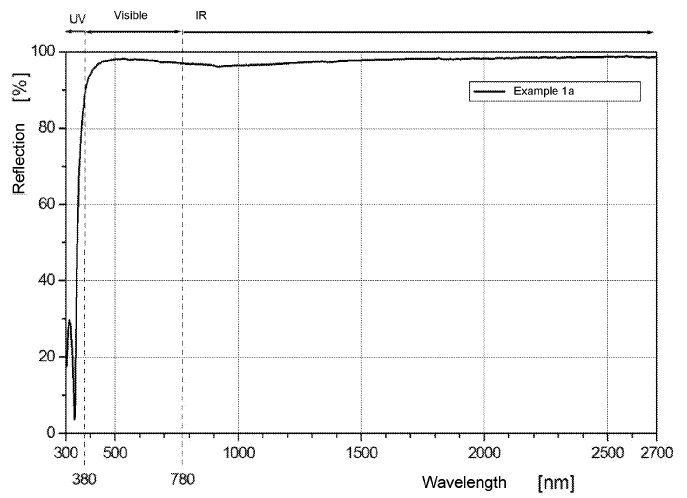
US10436744 — PHOTO-ACOUSTIC DEVICE AND METHOD FOR NON-CONTACT MEASUREMENT OF THIN LAYERS — Novelis Inc. (USA) — The present invention comprises a measuring device for non-mechanical-contact measurement of a layer, the measuring device including a light source operative to generate a pulse adapted to interact with the layer so as to generate a thermal wave in a gas medium present adjacent the layer. The thermal wave causes an acoustic signal to be generated and measured by a device adapted to detect a first signal responsive to the acoustic signal, the detector not being in mechanical contact with the layer. For example, to improve the corrosion resistance and the adhesion of lacquers, seals and adhesives on aluminum strips, a conversion coating may be applied through a process called coil-coating. During production it may be necessary to monitor the quality of the applied conversion coating and/or their chemical composition in real-time. In a coil-coating process, the aluminum strip may move with a speed up to several hundred meters per minute through the production machinery. Therefore, a fast, real-time, nondestructive and non-mechanical-contact measurement technique for conversion layers that is insensitive to noise, dirt and shocks suitable for use in the coil coating manufacturing process is desired.
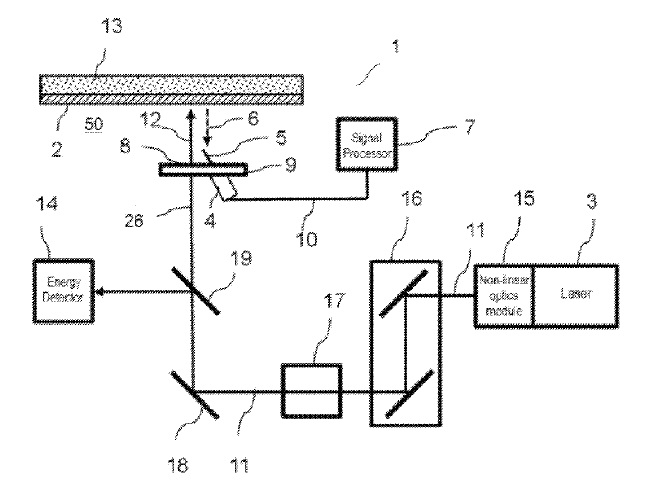
US10435805 — TWO-STAGE METHOD FOR DIP-COATING ELECTRICALLY CONDUCTIVE SUBSTRATES USING A BI (III)-CONTAINING COMPOSITION — BASF Coatings GmbH and Henkel AG & Company, KGaA (Germany) — The present invention relates to a method for at least partly coating an electrically conductive substrate with an electrocoat material, comprising at least contacting the substrate with an aqueous coating composition (A) as step (1), which is carried out in at least two successive stages (1a) and (1b), i.e., first at an applied voltage in a range from 1 to 50 V (1a), which is applied over a duration of at least 5 seconds, and then in a range from 50 to 400 V (1b), the voltage applied in (1b) being greater by at least 10 V than the voltage applied in (1a), with (A) comprising at least one cathodically depositable binder (A1), at least one organic monocarboxylic or polycarboxylic acid which has no nitrogen atom(s), and/or anions thereof (A3) and trivalent bismuth (A4), with (A3) and (A4) each being present in (A) in an amount such that their stoichiometry to one another allows at least 50 mol % of (A4) to be present in the form of a salt and/or complex of components (A3) and (A4), with the molar fractions of any zirconium ions and aminopolycarboxylic acids present in (A) to be lower by a factor in each case of 100 or of 15, respectively, than the molar fraction of (A4) present in (A); to a use of (A) for at least partly coating the substrate with an electrocoat material; to at least partly coated electrically conductive substrates obtainable by the method; and to articles or components produced from such substrates. Particularly suitable electrically conductive substrates used in accordance with the invention are galvanized steel and aluminum, used in the automotive sector. Substrates coated by the inventive method with an inventively employed aqueous coating composition, in comparison to comparative examples, consistently show an improved corrosion prevention effect.
US10435199 — COMPOSITIONS FOR CONTAINERS AND OTHER ARTICLES AND METHODS OF USING SAME — SWIMC LLC (USA) — Various coatings have been used as interior protective can coatings, including polyvinyl-chloride-based coatings and epoxy-based coatings incorporating bisphenol A (“BPA”). Each of these coating types, however, has potential shortcomings. For example, the recycling of materials containing polyvinyl chloride or related halide-containing vinyl polymers can be problematic. There is also a desire by some to reduce or eliminate certain BPA-based compounds commonly used to formulate food-contact epoxy coatings. This invention provides a polymer which is preferably a polyether polymer useful in a variety of applications, for example, as a binder polymer of a coating composition. In preferred embodiments, the polymer does not include any structural units derived from bisphenol A (“BPA”), bisphenol F (“BPF”), bisphenol S (“BPS”), or any diepoxides thereof (e.g., diglycidyl ethers thereof such as the diglycidyl ether of BPA (“BADGE”). The polymer may be used in coating compositions. Containers and other articles comprising the polymer and methods of making such containers and other articles are also provided. The invention further provides compositions including the polymer (e.g., powder coatings), which have utility in a variety of coating end uses, including, for example, valve and pipe coatings.
US10388455 — COIL COATING PROCESS — voestalpine Stahl GmbH (Austria) — The object of the invention is to create a coil coating method able to reproducibly ensure achievement of a stable electrical and/or magnetic functionalization of a metal strip. In addition, the coil coating method should be easy and inexpensive to use. A coil coating method for multilayer coating of a continuous metal strip, which is disposed in the strip passage, in which on a flat side of the metal strip, a curable polymer primer is applied by means of a roller application and cured in order to form an electrically insulating primer layer and a curable polymer varnish is applied onto said primer layer by means of roller application and cured in order to form an electrically insulating varnish layer, wherein at least one at least electrically conductive conductor track is printed on at least some areas between the primer layer and the varnish layer is proposed. In general, it should be noted that the metal strip can be a steel strip, an aluminum strip, or a strip composed of alloys thereof. In order to increase the reproducibility of the coil coating method, it is proposed that the conductor track be printed on some areas of the pre-cured primer layer and that the conductor track and varnish be applied using a wet-on-wet process.
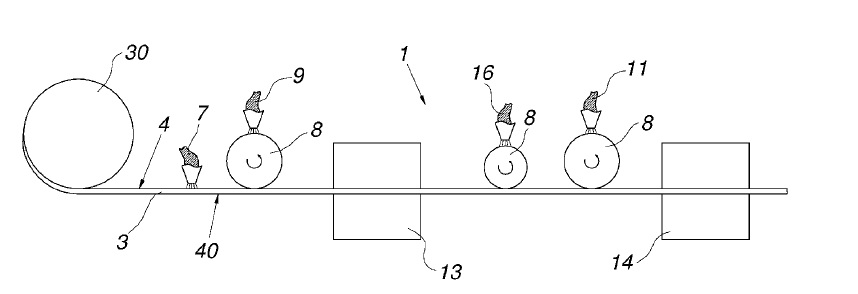
US10377912 — CONTAINER COATING COMPOSITIONS — PPG Industries Ohio, Inc. (USA) — Compositions comprising polyesters and resole resins have been investigated as substitutes for the bisphenol A-containing epoxy resins used to coat aluminum and steel food and beverage containers. Although these compositions have good cured coating properties, such as solvent resistance and corrosion resistance and inertness to many foods and beverages, they have insufficient flexibility to withstand the forming process leading to cracks and fissures in the cured coating resulting in coating failure. The present invention overcomes these problems by providing a polyester-resole composition that has enhanced flexibility while maintaining good cured coating properties. A coating composition comprising a polyester, a mixture of novolak and resole resins and a vinyl chloride polymer, and the use of these compositions to coat metal containers is disclosed. It is believed that the mixture of novolak and resole resins provides an excellent blend of thermoset film properties along with the flexibility needed in the container-forming process.
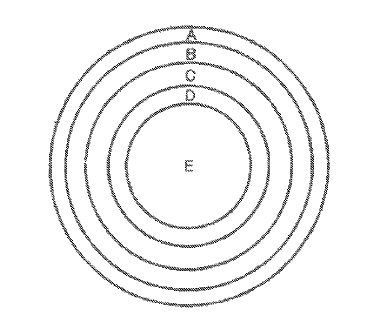
US10370151 — CONTAINERS COATED WITH COMPOSITIONS HAVING ENHANCED HEAT-AGING PROPERTIES — PPG Industries Ohio, Inc. (USA) — Hydroxyl and carboxylic acid functional polyesters curable with aminoplast or phenolplast curing agents provide suitable container coating compositions, however, such compositions can exhibit poor heat-aging properties, suffering from poor humidity resistance when the cured coating is exposed to high humidity conditions at elevated temperatures. The present invention is directed to an article comprising: (a) a substrate of a food or beverage container including a portion thereof, (b) a crosslinked coating applied to at least a portion of the substrate; the cured coating being derived from a coating composition comprising: (i) a polyester resin that is prepared by reacting: (A) a polyester resin containing terminal carboxylic acid groups having an acid number of at least 5, with (B) an end capping agent that reacts with the carboxylic acid groups to reduce the acid number to below 2; (ii) a crosslinking agent. The invention also provides for applying the coating composition to a substrate prior to or after forming the aluminum or steel substrate into a food or beverage container or portion thereof and heating the coated substrate to a temperature and for a time sufficient to crosslink the coating composition.
US10358571 — AQUEOUS COATING COMPOSITIONS INCLUDING PHENOLIC RESIN(S) — The Sherwin-Williams Company (USA) — The present invention relates to strategies by which one or more phenolic resins are provided in aqueous phenolic dispersions in a manner so that the resultant aqueous phenolic dispersions are more easily combined with water-based latex compositions. The principles of the present invention make it much easier to formulate water-based latex compositions in which substantial phenolic resin content can be stably dispersed for long periods of time. In one aspect, the present invention relates to a method of making a coating composition, comprising a) providing an inverted aqueous dispersion comprising i) at least one polymer having one or more polar, hydrophilic groups; and ii) at least one phenolic resin; b) providing a latex composition; and c) blending the latex composition with the aqueous dispersion to form the coating composition. Cured compositions of the present invention preferably adhere well to metal and provide high levels of resistance to corrosion or degradation that may be caused by prolonged exposure to products such as food or beverage products. This makes the coating compositions of the present invention particularly useful in single or multilayer coating systems that are used to protect metallic substrates. A wide variety of containers may be protected by the coatings: cans, drums, kegs, pails, tubes, bottles, etc.
US10351714 — COATING COMPOSITIONS FOR PACKAGING ARTICLES SUCH AS FOOD AND BEVERAGE CONTAINERS — SWIMC LLC (USA) — An article, comprising a packaging article such as food or beverage container (20), or a portion thereof, that includes a substrate (30, 32) and a coating (34) disposed on at least a portion of the substrate (30, 32). The coating (34), which may be applied in a coil or sheet coating operation that is then formed into the can end or body, is preferably formed from a coating composition that comprises a latex emulsion having a first-stage copolymer, a second-stage copolymer, and a linkage interconnecting the first-stage copolymer and the second-stage copolymer prior to curing. Alternatively, liquid coating compositions of this invention may be applied (e.g., by spraying, dipping, rolling, etc.) to the formed or partially formed article and then hardened (e.g., cured).
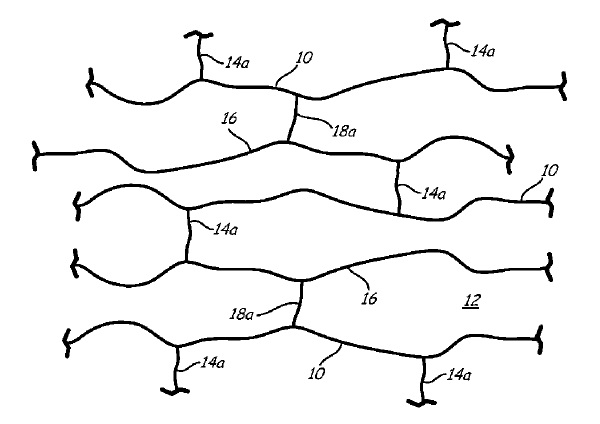
US10316211 — STABILIZER AND COATING COMPOSITIONS THEREOF — SWIMC LLC (USA) — There is a desire to reduce or eliminate certain bisphenol A-based compounds commonly used to formulate food-contact coatings. The present invention provides coating compositions that include a thermoplastic dispersion and an epoxy-functional stabilizer having polyhydric phenols that exhibit estrogenic activity less than bisphenol S.
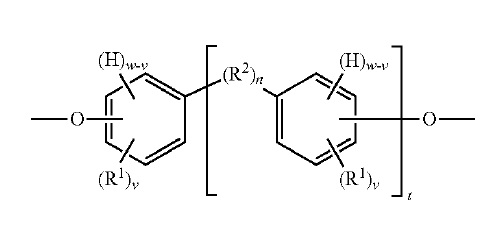
US10287690 — SORBENT-COATED ALUMINUM STRIP — Hydro Aluminium Deutschland GmbH (Germany) — Sorption rotors are typically used for dehumidifying air and have thin channels which are coated with sorbents. In this way, a surface coated with sorbents which is as large as possible can be provided. The sorbent now takes up water vapor, for example, by adsorption or absorption from the air flowing through the air channels. This continues until the sorbent is saturated and is then regenerated. The invention relates to a method for producing an aluminum strip, in which the aluminum strip is coated with a sorption layer which has a binder and a sorbent. The object to propose a method for producing an aluminum strip coated with a sorption layer, by means of which an aluminum strip can be coated cost-effectively having constant performance characteristics with respect to the sorption of, for example, water vapor, is achieved according to the invention by means of a method for producing an aluminum strip coated with a sorption layer by applying a suspension to the aluminum strip in the coil-coating process, which in addition to a liquid comprises at least one binder, formed as a solid, and a sorbent, and by subjecting the aluminum strip, together with the applied suspension, to a drying process, in which the binder is activated.
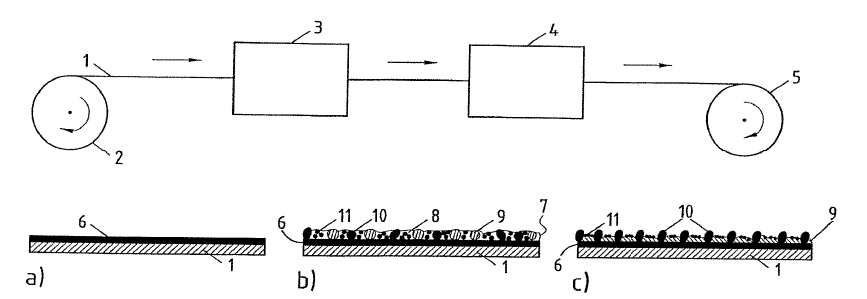
US10280332 — PHOSPHATIZED POLYESTERS AND COATING COMPOSITIONS CONTAINING THE SAME — PPG Industries Ohio, Inc. (USA) — A coating composition comprising a resinous binder and up to 10 percent by weight of a phosphatized polyester. The compositions are useful for coating containers of all sorts such as food and beverage containers made of steel or aluminum, and the phosphatized polyester provides enhanced adhesion of the coating to the container substrate. The compositions can be formulated to be substantially free of bisphenol A (BPA) and bisphenol A diglycidyl ether (BADGE). The phosphatized polyester comprises the reaction product of: (a) a polyester having an Mn of 2000 to 10,000, a hydroxyl number of 20 to 75, and an acid value of 15 to 25; the polyester being a polycondensate of: (i) a polyol component comprising a mixture of diols and triols, (ii) a polyacid component comprising an alpha, beta-ethylenically unsaturated polycarboxylic acid, and (b) a phosphorus acid.
US10272390 — ADHESION PROMOTER COMPOSITIONS AND PRIMER COMPOSITIONS FOR METAL-PLASTIC HYBRID COMPONENTS — Evonik Degussa GmbH and SI-Coatings GmbH (Germany) — The present invention relates to an adhesion promoter composition and a primer composition and to the use thereof for production of hybrid components, to processes for production thereof and to a metal substrate. Examples of suitable metals are steel, and alloys of aluminum, magnesium, and titanium. The motor vehicle and aircraft construction sectors increasingly use hybrid components in order to reduce mass and obtain optimized mechanical properties. The invention provides an adhesion promoter composition comprising at least one polymer A selected from at least one epoxy resin-phenol resin precondensate, a mixture of at least one epoxy resin-phenol resin precondensate and epoxy resins, a mixture of epoxy resins and phenol resins, polyamide resins and mixtures thereof, and at least one copolyamide-based hotmelt adhesive. Additionally described is a primer composition comprising at least one polymer B selected from saturated polyester resins, epoxy-phenol resin precondensates, mixtures of epoxy resins and phenol resins, and mixtures thereof, at least one crosslinker resin selected from the group consisting of melamine resins, blocked isocyanate resins and mixtures thereof, at least one catalyst, and at least one copolyamide-based hotmelt adhesive. Coating of the metals by means of coil coating is desirable, in order to provide a way of rapidly providing hybrid components in a manner suitable for mass production, for example for the automotive sector.
US10273380 — COATING COMPOSITION FOR METAL SUBSTRATES — The Sherwin-Williams Company (USA) — The present invention provides novel packaging articles, e.g., food and beverage cans. These cans are generally coated using “coil coating” operations, i.e., a planar sheet of a suitable substrate (e.g., steel or aluminum metal) is coated with a suitable composition and, cured and then the coated substrate is formed into the can end or body made of aluminum and are coated on at least one major surface with a coating composition of the present invention. Suitable coating compositions of the present invention comprise: one or more polyester resins, wherein at least one of the polyester resins has a glass transition temperature (Tg) less than about 50oC., and wherein the polyester resin is formed by the reaction of one or more polyacid molecules and one or more polyol molecules; and a crosslinker. Preferred compositions are substantially free of mobile BPA and aromatic glycidyl ether compounds, e.g., BADGE, BFDGE and epoxy novalacs (e.g., NOGE) and more preferred compositions are also substantially free of bound BPA and aromatic glycidyl ether compounds. In more preferred embodiments (e.g., alcoholic beverage cans), the polyol molecules used to make the polyester resin are substantially free of NPG. The present invention also provides a method of making such cans.
US10266640 — CURABLE EPOXY RESIN COMPOSITION — Dow Global Technologies LLC (USA) — The present invention is related to a curable epoxy resin composition and more specifically, the present invention is related to a curable epoxy resin coating composition having a low viscosity which is useful in coil coating of strip metal such as steel or aluminum. The strip metals are typically coated with several layers on both surfaces of the strip metal; and one of the layers is a backer coating layer. Therefore, it is desired to prepare an advanced epoxy resin composition exhibiting a good balance of performance properties such as a high mechanical strength performance, a high temperature performance, and a high chemical resistance performance such that the epoxy resin composition can be used in producing a backer coating for coil. The subject of this invention is an advanced epoxy resin including a reaction product of (A) at least one epoxy resin; (B) at least one cashew nutshell liquid; and (C) at least one multifunctional carboxylic acid; a curable epoxy resin composition prepared using the above advanced epoxy resin; and the use of the above curable epoxy resin composition to prepare a coating.
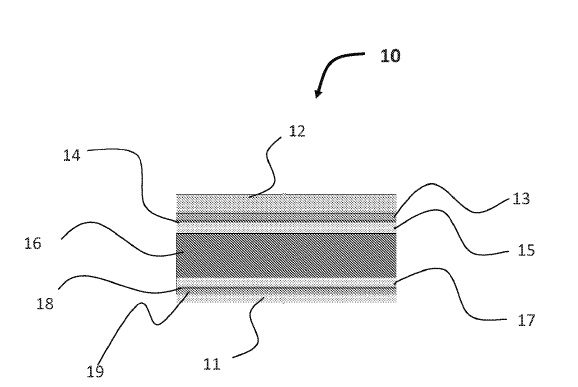
US10266455 — COATING SUITABLE FOR MEDICAMENT CONTACT — The Sherwin-Williams Company (USA) — A coating composition is provided that is suitable for use on a medicament-contact surface such as drug-dispensing articles such as metered dose inhalers (“MDIs”). Traditionally, these containers have been formed from aluminum and have a bare metal inner surface for contacting the medicament. These metal surfaces have typically suffered from several drawbacks which include, for example, adsorption of drug onto the metal surfaces (which can result in inconsistent or reduced drug delivery), reduced drug stability, and possible contamination of the drug. Despite these shortcomings, however, bare metal surfaces are still widely used for medicament containers such as MDI cans. This invention relates to an improved polymer coating composition, and particularly an improved water-based coating composition for use in coating substrates exposed to medicaments. The coating composition preferably includes one or more acrylic-containing polymer and a carrier. In preferred embodiments, the coating composition is an aqueous dispersion or solution.
US10253188 — COMPOSITION COMPRISING A CONTINUOUS ORGANIC PHASE AND A WATER-IN-OIL EMULSION FOR COVERING A METAL SURFACE, AND METHOD FOR PRODUCING SAID COMPOSITION — Societe Nouvelle Des Couleurs Zinciques (France) — A composition to cover a metal surface comprises an organic continuous phase comprising at least one anticorrosive pigment, and a hydrophilic phase dispersed in the organic continuous phase, the hydrophilic phase comprising a chemical agent for the surface treatment of the metal surface. The surface treatment chemical agent can advantageously be cerium nitrate. A process for the manufacture of a composition according to the present invention is provided. While the pretreatment operation is carried out in the presence of an aqueous solution, the operation of coating the adhesion primer is carried out in the solvent phase, the combined operations thus comprising two types of operations in different media. Starting from this context and from all the parameters present, the applicant turned to the principles of encapsulation and of controlled release in order to enhance the performance of a functional agent.
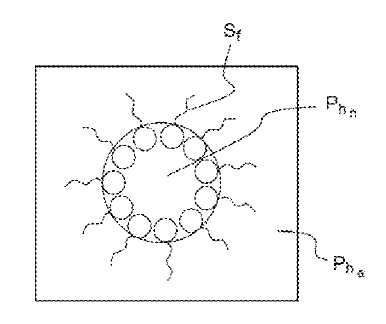
US10233349 — ACRYLIC AQUEOUS DISPERSIONS FOR CONTAINER COATINGS — PPG Industries Ohio, Inc. (USA) — The present invention provides an article comprising a body portion or an end portion of a food or beverage can and a coating composition disposed thereon wherein the coating composition comprises an aqueous dispersion that is the reaction product of: (a) a hydrophobic vinyl addition polymer containing pendant ethylenically unsaturated groups, (b) a mixture of vinyl monomers including a vinyl monomer containing carboxylic acid groups; the reaction product containing active hydrogen groups and being at least partially neutralized with a base and dispersed in aqueous medium; the aqueous dispersion being substantially free of bisphenol A and derivatives thereof. The invention further provides a method comprising: (a) providing a coating composition comprising the above-mentioned aqueous dispersion, (b) applying the coating composition to a metal substrate prior to or after forming the metal substrate into a food or beverage can or portion thereof.
US10221327 — WATER BORNE POLYOLEFIN DISPERSION COATINGS, AND METHODS OF MAKING — Dow Global Technologies LLC (USA) — The present invention provides aqueous polyolefin dispersion compositions for use in metal coatings, such as can coatings, comprising one or more polyolefin base polymer, one or more at least partially neutralized olefinic stabilizing agent having an acid number (AN) of from 80 to 250, preferably, a polyolefin stabilizing agent, such as an olefin-carboxylic acid copolymer or a blend of two such polymers, an optional coupling agent having an acid number (AN) of from 10 to 70 and a melt index of from 500 to 5,000,000 grams of polymer melt passing in 10 minutes through a heated syringe or cylinder at 190.degree. C. with a plunger loaded with 2.16 kg, preferably, a polymer, and a hindered phenolic antioxidant containing an ester linkage dispersed in the polyolefin dispersion composition. The hindered phenolic antioxidant containing an ester linkage can be masterbatched with a polyolefin base polymer, polyolefin stabilizing agent or a coupling agent which is a polymer, melt mixed with the remaining polyolefin composition and then dispersed with aqueous media and a neutralizing agent to form the aqueous dispersion. These metal coatings and compositions enable provision of a coating or film possessing excellent thermal stability throughout and after processing.
US10215855 — COATINGS FOR INCREASING NEAR-INFRARED DETECTION DISTANCES — PPG Industries Ohio, Inc. (USA) — New detection systems, especially for autonomous vehicles, that can increase the detection distance and produce detectable signals in non-ideal environments are desirable. The present invention is directed toward a method for increasing a detection distance of a surface of an object illuminated by near-IR electromagnetic radiation, including: (a) directing near-IR electromagnetic radiation from a near-IR electromagnetic radiation source towards an object at least partially coated with a near-IR reflective coating that increases a near-IR electromagnetic radiation detection distance by at least 15% as measured at a wavelength in a near-IR range as compared to the same object coated with a color matched coating which absorbs more of the same near-IR radiation, where the color matched coating has a ∆E color matched value of 1.5 or less when compared to the near-IR reflective coating; and (b) detecting reflected near-IR electromagnetic radiation reflected from the near-IR reflective coating. A system for detecting proximity of vehicles is also disclosed.
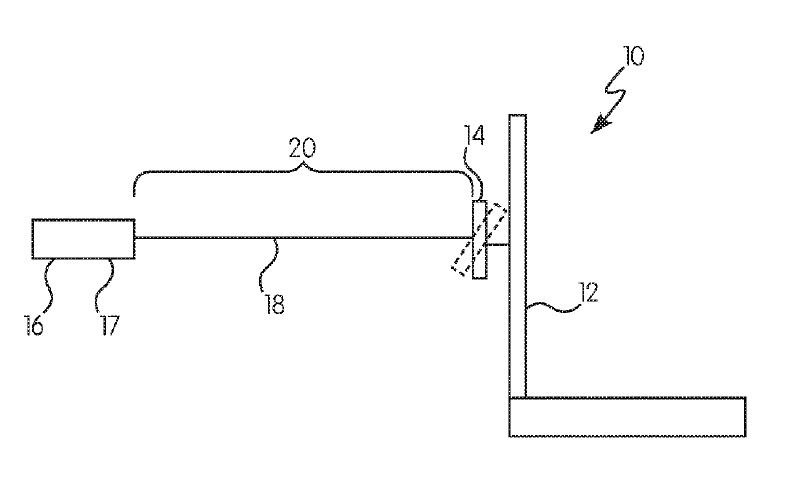
US10208213 — DIP-COATING COMPOSITION FOR ELECTRO-CONDUCTIVE SUBSTRATES, COMPRISING A SOL-GEL COMPOSITION — BASF Coatings GmbH and Henkel AG & Co. KGAA (Germany) — The present invention relates to an aqueous coating composition, used to protect automotive metallic components from corrosion, comprising at least one aqueous dispersion or solution (A) of at least one electrophoretically depositable binder and optionally of at least one crosslinking agent, and also at least one aqueous sol-gel composition (B), for at least partly coating an electrically conductive substrate with an electrocoat material, where the aqueous sol-gel composition (B) is obtainable by reaction of at least one starting compound suitable for preparing the sol-gel composition (B) with water, with hydrolysis and condensation of the at least one starting compound, to a method for producing the coating composition, to the use thereof for at least partly coating an electrically conductive substrate with an electrocoat material, to a method for at least partly coating an electrically conductive substrate with an electrocoat material by at least partial electrophoretic deposition of the coating composition on the substrate surface, to an electrically conductive substrate at least partially coated therewith, and to an article or component produced from at least one such substrate. In particular, moreover, it is an object of the present invention to provide coating compositions which make it possible to forgo the phosphatizing operation that normally needs to be carried out using a metal phosphate prior to dip coating, but with which, nevertheless, it is possible to achieve at least the same corrosion prevention effect which can also be achieved with the coating compositions commonly employed.
US10208209 — AQUEOUS AGENT AND COATING METHOD FOR THE ANTICORROSIVE TREATMENT OF METALLIC SUBSTRATES — Thyssenkrupp Steel Europe AG (Germany) — The object of this invention is to provide an aqueous agent for the anticorrosive treatment of metallic substrates, which has the best possible properties with regard to corrosion protection and involves the least possible negative environmental influences. This is achieved with an aqueous agent for the anticorrosive treatment of metallic substrates and to a method for coating such substrates. The aqueous agent according to this invention includes at least one compound that dissociates into zirconium- or titanium-fluorine complexes in aqueous solution, at least one water-soluble compound that releases metal cations, the metal cations being selected from the group composed of: iron-, copper-, or silver ions, and a water-soluble alkoxysilane that has at least one epoxy group. This invention also includes the metallic substrate that has been treated or coated by the method described above. The suitable substrates particularly include Zn-Al alloys, electrolytically galvanized strip steels, Zn-Al-Mg alloys, aluminum and its alloys (including cast alloys), iron- and steel surfaces, and magnesium alloys.
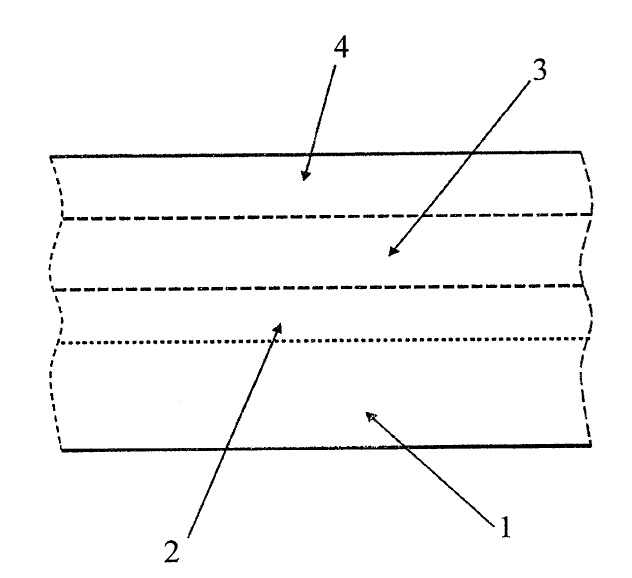
US10174212 — METHOD FOR PRODUCING A PIGMENT PASTE, AQUEOUS ELECTROCOAT MATERIAL, USE THEREOF, METHOD FOR CATAPHORETIC ELECTROCOATING, AND COATED ARTICLE — BASF Coatings GmbH and Henkel AG & Co. KGAA (Germany) — The invention relates to a method for producing a pigment paste, used in the pigmenting of paints, varnishes, and printing inks, which comprise a curable resin system. and an electrocoat containing the paste, the past being made by mixing solid pigment particles with a grind resin in the presence of water and/or an organic liquid, wherein the grind resin includes a dispersion of core-shell particles in an epoxide prepolymer which is liquid at 20oC. and the core-shell particles have a silicone core and a polymer shell. The invention related to the use of an aqueous electrocoat material as disclosed herein for the cataphoretic electrocoating of metal surfaces, more particularly of automotive aluminum surfaces, using an aqueous electrocoat material as disclosed herein. In one preferred embodiment the electrically conductive substrate used in accordance with the invention is not a phosphatized or chromate pretreated substrate.
US10125424 — ZIRCONIUM PRETREATMENT COMPOSITIONS CONTAINING MOLYBDENUM, ASSOCIATED METHODS FOR TREATING METAL SUBSTRATES, AND RELATED COATED METAL SUBSTRATES — PPG Industries Ohio, Inc. (USA) — Provided are methods for treating a metal substrate that overcome at least some of the drawbacks of the prior art, including the environmental drawbacks associated with the use of chromates and/or phosphates. The provided methods for treating metal substrates imparts corrosion resistance properties that are equivalent to, or even superior to, the corrosion resistance properties imparted by phosphate or chromium conversion coatings. Disclosed are pretreatment compositions and associated methods for treating metal substrates with pretreatment compositions, including ferrous and aluminum substrates. The pretreatment composition includes: Group IIIB and/or IVB metal. free fluoride, and molybdenum. The methods include contacting the metal substrates with the pretreatment composition.
US10094027 — SELF-CLEANING SUBSTRATES AND METHODS FOR MAKING THE SAME — Arconic INC. (USA) — Titanium dioxide (TiO2) may facilitate photocatalysis in the right environmental conditions. However, applying coatings containing TiO2 to substrates, such as for architectural products, without detrimentally affecting the aesthetic features of such substrates has proven difficult and cost ineffective. Methods, apparatus, and compositions for producing colored, self-cleaning substrates by coil coating are provided. The coil coated, colored, self-cleaning substrates retain the predetermined color and a predetermined gloss of the colored coating, thereby facilitating their use in architectural applications. The coil coated, colored, self-cleaning substrates may be iridescent-free.
US10077373 — POLYVINYL FLUORIDE PAINT AND BI-LAYERED COATING AND METHOD FOR MANUFACTURING THE SAME — Grank Tek Advance Material Science Co., Ltd. (Taiwan) — The disclosure relates to a polyvinyl fluoride paint for a coil. The substrate may be a pre-coated coil such as a cold rolled steel coil, a zinc coated steel coil, or an aluminum sheet after a surface treatment, a continuous roller coating, baked, and cooled. Pre-coated coils are widely applied in the field of architecture due to their many advantages, which include an aesthetic appearance, a uniform coating film, a bright color, a high intensity, and good formability. A method of manufacturing a bi-layered coating is provided, which includes applying a primer paint on a substrate, wherein the primer paint includes 100 parts by weight of a first polyvinyl fluoride, 20 to 50 parts by weight of an assistance resin, and 150 to 170 parts by weight of a first latent solvent, and wherein the assistance resin is polyester modified epoxy resin, polyester type polyurethane resin, phenoxy resin, or a combination thereof. The primer paint is baked and dried to form a primer coating. A finish paint is then applied onto the primer coating, wherein the finish paint includes 100 parts by weight of a second polyvinyl fluoride and 120 to 150 parts by weight of a second latent solvent. The finish paint is baked and dried to form a finish coating on the primer coating.
US10072176 — FLEXIBLE NON-CHROMATE CORROSION INHIBITIVE PRIMER — PRC-DeSoto International, Inc. (USA) — Primer coating compositions include a thiol-terminated urethane-containing polyether prepolymer, a polyepoxide, calcium carbonate, and magnesium oxide. Compositions provided by the present disclosure can comprise a non-chromate corrosion inhibitor comprising magnesium oxide. The magnesium oxide can comprise magnesium oxide particles, magnesium oxide nanoparticles, or a combination thereof. The use of a combination of calcium carbonate and magnesium oxide results in a synergistic improvement in the corrosion resistance compared to the use of magnesium oxide alone or with the use of magnesium oxide and a lesser amount of calcium carbonate. The coating compositions are useful as corrosion resistant primers in aerospace applications and provide non-chromate primer coatings that exhibit the adhesion of thermosetting epoxy systems and the flexibility of polyurethane coatings.
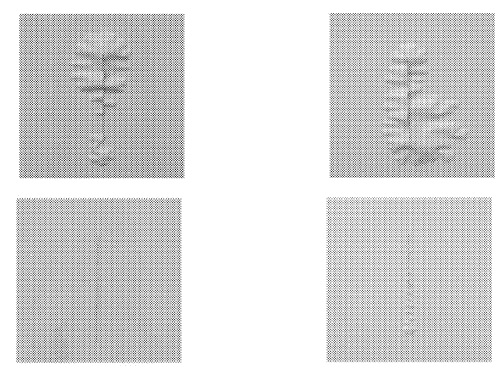
US10017861 — ZIRCONIUM PRETREATMENT COMPOSITIONS CONTAINING A RARE EARTH METAL, ASSOCIATED METHODS FOR TREATING METAL SUBSTRATES, AND RELATED COATED METAL SUBSTRATES — PPG Industries Ohio, Inc. (USA) — The present invention relates to pretreatment compositions, methods for treating a metal substrate, including aluminum containing substrates and ferrous substrates, such as cold rolled steel and electrogalvanized steel to improve corrosion resistance and paint adhesion without the use of phosphate and chromate containing compositions, which pose environmental and health concerns. The present invention also relates to coated metal substrates. Disclosed are methods for treating metal substrates that include contacting the substrate with a pretreatment composition comprising a rare earth metal from Group IVB and Group VB and a zirconyl compound. The present invention also relates to coated substrates produced thereby and further to substrates additionally coated with an electrophoretically applied coating composition.
US10011907 — METHOD FOR THE MANUFACTURE OF A SUBSTRATE PROVIDED WITH A CHROMIUM VI-FREE AND COBALT-FREE PASSIVATION — Ewald Doerken AG (Germany) — A method for the manufacture of a substrate provided with a chromium VI-free and a cobalt-free passivation by the application of a first acidic passivation and a second alkaline passivation, containing a silane-modified and/or a siloxane modified silicate, with which an improved protection against corrosion is achieved, an aqueous, acidic composition for passivating and a passivated substrate, and a device for applying the passivation. Within the scope of the inventive method, the acidic, aqueous compositions for passivating metallic substrates preferably contain one or more elements or compounds of the group comprising molybdenum, manganese, cerium and lanthanum. A further improvement in the anticorrosive properties of the inventive passivation is attained by the addition of these elements or the compounds thereof and, preferably, of the salts and oxides thereof.
US9993842 — BISPHENOL A AND AROMATIC GLYCIDYL ETHER-FREE COATINGS — SWIMC LLC (USA) — The invention relates to protective coating compositions and methods for coating metal substrates useful in fabricating, for example, packaging containers. The invention also relates to foodstuffs packaging containers, particularly multi-part containers with “easy-open” end closures, having an interior surface coated with such protective coatings. Disclosed are Bisphenol A (BPA), Bisphenol F, Bisphenol A diglycidyl ether (BADGE), and Bisphenol F diglycidyl ether (BFDGE)-free coating compositions for metal substrates including an under-coat composition containing a polyester (co)polymer, and an under-coat cross-linker; and an over-coat composition containing a poly(vinyl chloride) (co)polymer dispersed in a substantially nonaqueous carrier liquid, an over-coat cross-linker, and a functional (meth)acrylic (co)polymer. Also provided is a method of coating a metal substrate using the BPA, BPF, BADGE and BFDGE-free coating system to produce a hardened protective coating useful in fabricating metal storage containers.
